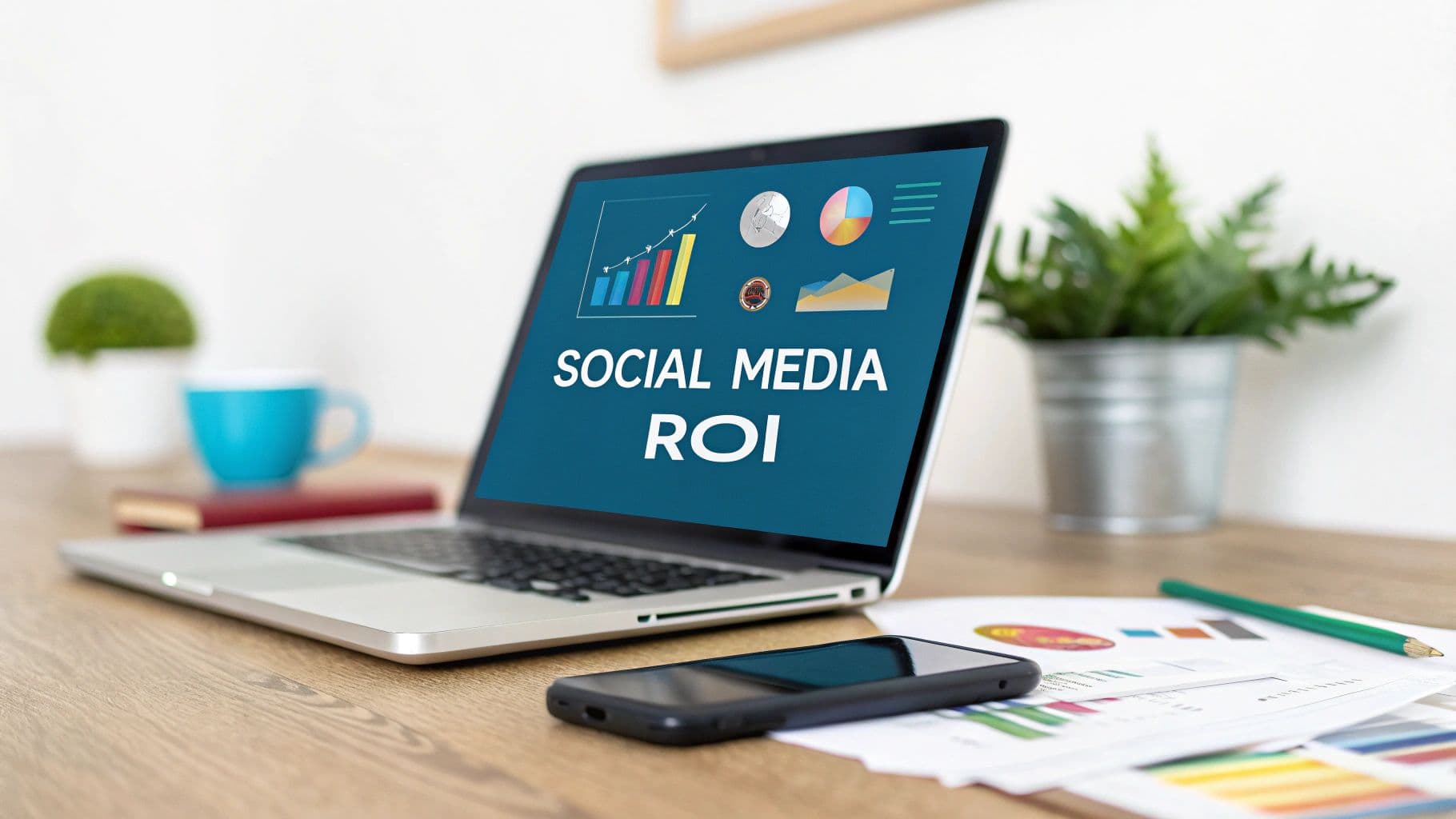
Forget theory. Let's talk about how to draw a straight line from a Reddit comment or a tweet to actual revenue. Calculating social media ROI isn't about appeasing your board with vanity metrics; it's about knowing if your time and money are actually growing your business. It means tracking your total investment—time, ad spend, tools—and putting a dollar value on what you get back. We're skipping the fluffy stuff like likes and followers and focusing on what pays the bills: leads, conversions, and customer lifetime value.
Moving Beyond Likes To Real ROI
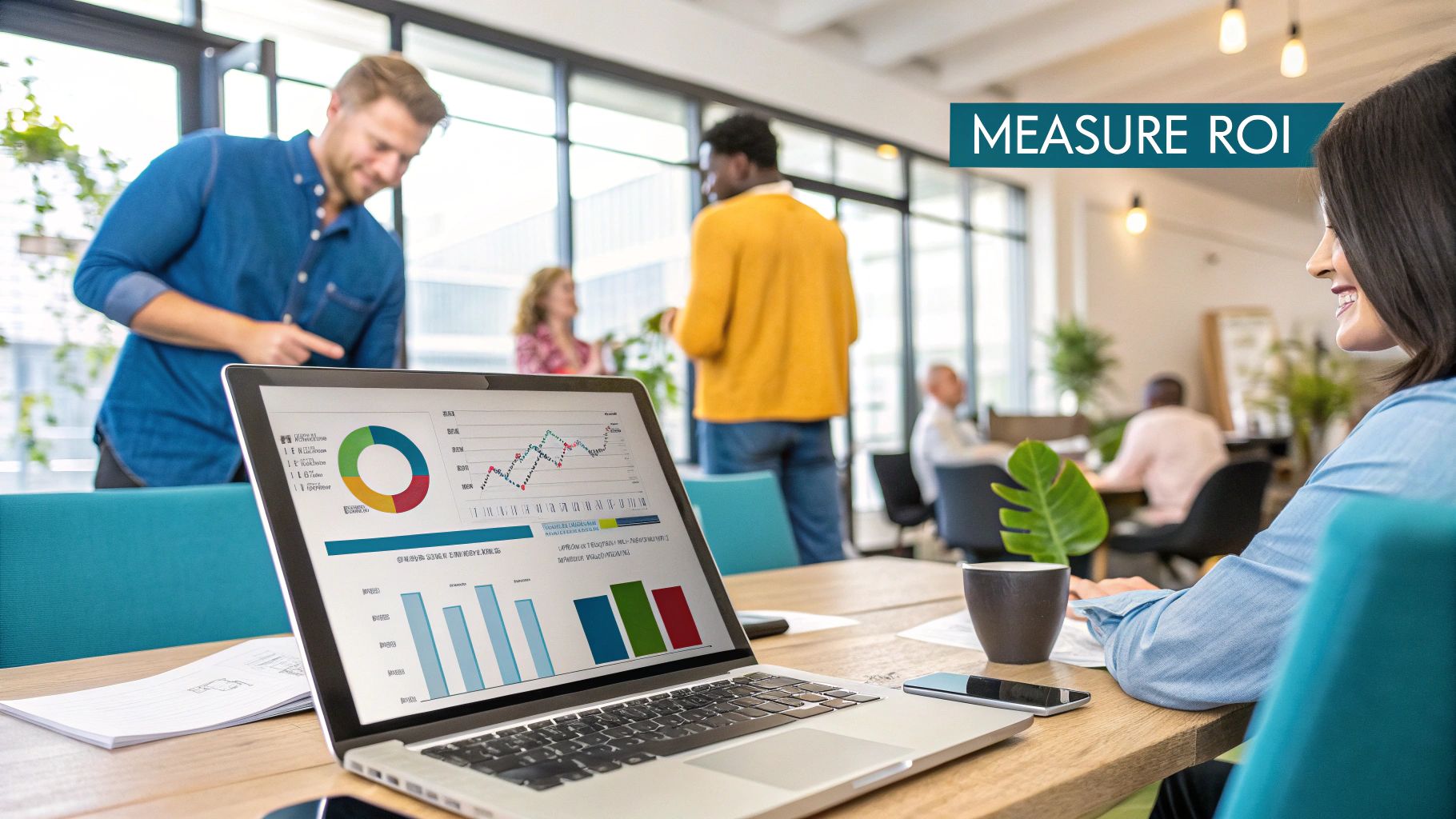
Let's be honest. For too long, "success" on social media was about metrics that looked good in a slide deck but didn't impact the bottom line. I've been there—getting excited about a new follower milestone, only to realize our MRR didn't budge. That had to change.
At BillyBuzz, we made a hard pivot. The lightbulb moment was realizing every minute and dollar we spent on social had to have a clear, traceable path back to revenue. This isn't just a concept; it’s the practical shift that separates busywork from a profitable growth strategy. We started asking the hard questions: Did that viral post actually bring in a qualified lead? Did that follower growth translate into paying customers?
The Mindset Shift: From Volume to Value
The first step in measuring social media ROI is mental. Stop thinking of social media as a brand megaphone and start treating it like a performance channel, right alongside Google Ads and email.
This isn't just a niche idea anymore; it's the standard. A recent study found that 77% of marketers in the USA say that proving ROI is a much bigger priority now than it was just two years ago. The old-school vanity metrics just don't cut it anymore. Today, it’s all about the KPIs that are directly tied to revenue. You can dig deeper into the evolving landscape of ROI measurement and see why so many businesses are making this shift.
As founders, our most precious resource is time. If we're spending it on something that isn't contributing to growth—whether that’s leads, sales, or customer LTV—it's just a distraction. Measuring ROI isn't about building fancy reports; it's about making sure we're putting our energy in the right places.
Defining What "Return" Means For Your Business
The "R" in ROI isn't a one-size-fits-all metric. Before you can even begin to measure it, you have to define what a "return" actually means for your specific business. What you value most is baked into your business model.
Here’s how that looks in the real world:
- For a B2B SaaS like BillyBuzz: Our world revolves around lead generation. A single MQL (Marketing Qualified Lead) from a deep conversation in
r/SaaSorr/startupsis infinitely more valuable to us than 10,000 impressions on a random tweet. - For an E-commerce Brand: It's all about direct sales. The only thing that really matters is the conversion rate from a click on an Instagram Shop post or a TikTok ad.
- For a Mobile App: The key return is getting people to install the app. Success is all about the cost per install (CPI) driven by your social campaigns.
This guide is built on the exact framework we use internally. We're going to walk you through how to define your objectives, track the right data, run the numbers, and—most importantly—use that information to make smarter decisions that actually grow your business.
Defining Your Objectives And Choosing The Right Metrics
Trying to measure social media ROI without clear objectives is like driving without a destination. You're moving, but you have no idea if you're getting any closer to where you want to go. This is the single most critical step in the entire process, and it's where we see most founders trip up.
At BillyBuzz, we have a hard-and-fast rule: every social media goal must directly support a broader company objective. We don't just "post on Reddit"; we set up alerts in subreddits like r/marketing and r/analytics for keywords like "social listening" or "brand monitoring tool" to drive sign-ups for our free trial. This alignment is non-negotiable.
Translate Big Goals Into Specific Metrics
Your company’s top-level goal might be something broad like "increase annual revenue by 20%." That's a great North Star, but it’s pretty useless for day-to-day social media management. The trick is to break it down into specific, trackable social media key performance indicators (KPIs).
You have to work backward from the business goal. If the objective is revenue, the social media goal naturally becomes generating leads or driving sales.
- Big Goal: Increase Sales
- Social Media KPI: The conversion rate from your social referral traffic.
- Big Goal: Grow User Base
- Social Media KPI: Your Cost Per Acquisition (CPA) from social ad campaigns.
- Big Goal: Improve Customer Retention
- Social Media KPI: The Customer Satisfaction (CSAT) score you get from social support interactions.
This translation process turns abstract business aims into concrete actions. It clarifies exactly what you need to track to prove your efforts are actually contributing to the bottom line.
Your Metrics Depend On Your Business Model
The metrics that matter most are entirely dependent on what you sell and who you sell it to. A B2B SaaS company and an e-commerce brand live in different universes when it comes to social media KPIs. Chasing the wrong ones is a fast track to wasting time and money.
Let’s look at two completely different scenarios:
- B2B SaaS Company (like us): Our primary platforms are Reddit and LinkedIn. Our main goal is generating qualified leads. Therefore, the metric we obsess over is the number of Marketing Qualified Leads (MQLs) coming from our content. We track exactly how many people book a demo from a link we shared in a helpful comment.
- E-commerce Brand: Their world is Instagram and TikTok. Their main goal is direct sales. They should be laser-focused on the conversion rate from Instagram Shops or the Return on Ad Spend (ROAS) from their TikTok influencer campaigns.
Picking the right metrics means choosing the few that have a direct, undeniable link to revenue. For us, a single demo booked from a Reddit conversation is more valuable than 10,000 views on a video. Know what moves your needle and ignore everything else.
Build A Metrics Hierarchy
To keep our team aligned, we use a simple "metrics hierarchy." This is just a way to connect our highest-level business goals to the daily activities of our social media manager. Think of it as a simple pyramid structure that ensures everyone understands how their work rolls up to the bigger picture.
It looks something like this:
- Top Level (Business Goal): Acquire 500 new paying customers this quarter.
- Mid-Level (Marketing Goal): Generate 1,000 Marketing Qualified Leads.
- Bottom Level (Social Media KPI): Achieve a 2% click-to-lead conversion rate on all social posts.
This framework makes reporting straightforward and keeps the team focused on activities that drive real results. For a deeper dive into connecting actions with outcomes, you can learn more about how AI measures social media engagement, which automates a lot of this tracking.
Setting this up inside your analytics tools is the final piece. In Google Analytics 4, we create custom conversion goals for events like "demo_booked_from_social" or "ebook_download_linkedin." This lets us see, in black and white, exactly how many valuable actions social media is driving, making our final ROI calculation clean and defensible.
Building Your Social Media ROI Measurement Toolkit
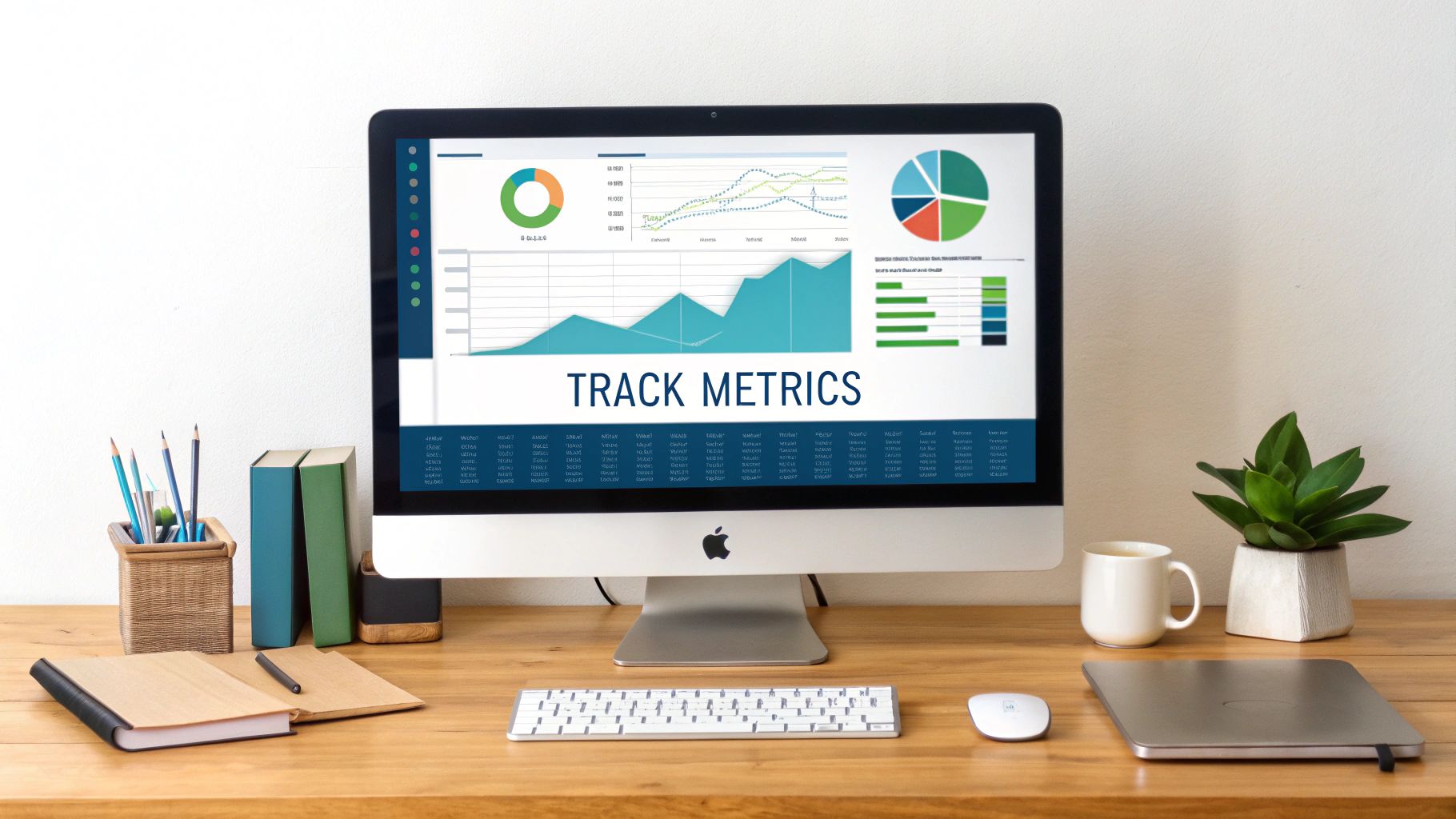
This is a peek inside our actual Google Analytics 4 dashboard. It’s not just a bunch of charts; it’s the story of how a visitor finds us on social media and what they do next. This is ground zero for calculating ROI, where we connect our social campaigns to real website actions. It’s how we stop guessing and start knowing what’s actually working.
You're probably swimming in data, but connecting the dots is the hard part. The most brilliant social strategy on earth falls flat if your tracking is broken. You’re just flying blind.
So, let's open up the toolkit we use right here at BillyBuzz. We’re going to walk through how we attribute real, monetary value back to every post, comment, and ad. This isn't about building some crazy, enterprise-level dashboard. It’s about a simple, solid system that delivers clean data you can actually trust. A solid foundation in data-driven marketing will give you a huge head start.
Master UTM Parameters to Track Every Click
If you only do one thing after reading this, do this: use UTM parameters on every single link you share. Seriously. These little tags, short for Urchin Tracking Modules, are the bedrock of good attribution. They’re just bits of text you add to a URL that tell your analytics exactly where a click came from.
Without them, all your hard-earned social traffic just gets dumped into a generic “social referral” bucket. You’ll have no idea if a conversion came from that killer LinkedIn post, a helpful Reddit comment, or your Instagram bio. That’s just not good enough when you need to justify your budget.
Here’s the exact naming system we use at BillyBuzz. Feel free to steal it.
- utm_source: The platform itself (e.g.,
reddit,linkedin,twitter). - utm_medium: The channel type (we use
social-organicorcommunity-outreach). - utm_campaign: The specific initiative (like
q3-feature-launchorsubreddit-r-saas). - utm_content: The specific link they clicked (e.g.,
comment-link,post-image,profile-bio).
This level of detail lets us see precisely which campaigns—and even which individual links within a post—are driving real value. Consistency is everything. A messy UTM strategy is almost as bad as having no strategy at all.
Connecting Platform Pixels with Google Analytics 4
Tools like the Meta Pixel or the LinkedIn Insight Tag are fantastic. They give you incredibly rich data on what people do inside their walled gardens. But if you only use them, you’re getting a very siloed view of the customer journey.
The real magic happens when you pair them with Google Analytics 4 (GA4). This is how you start to see the whole picture. The Meta Pixel can tell you someone clicked your ad, but GA4 can show you that they came back two days later through an organic search and then converted after seeing an email.
The goal isn't just to see the last click before a conversion. It's to understand the entire sequence of touchpoints that influenced that decision. GA4's data-driven attribution model is built for this, helping you assign partial credit to the social interactions that assisted in the final sale.
Our setup is a simple two-parter:
- Install the Pixels: Get the Meta Pixel, LinkedIn Insight Tag, and any others you use installed correctly on your website. This is completely non-negotiable for running effective paid ads.
- Set Up GA4 Conversion Goals: Decide what a "conversion" actually is for your business and define it in GA4. For us, we track goals like "demo_booked" and "trial_signup." These are the outcomes we’re driving toward.
With both systems running, we can cross-reference the data and get a much clearer picture. We see which ads are hitting the mark and how our organic social content is nurturing leads through the funnel.
Automate Your Reporting to Save Your Sanity
Last but not least, you need to get out of spreadsheet hell. Manually exporting CSVs from five different platforms every week is a one-way ticket to burnout and costly mistakes. We automate our social listening and engagement using BillyBuzz itself, which is a game-changer.
For instance, we have a real-time alert set up for the keyword "alternatives to Hootsuite" across subreddits like r/socialmedia and r/marketing. When it triggers, we get a notification, and we can jump in with a helpful comment using one of our pre-written response templates. This saves hours.
Then, we pipe our core KPIs into a Google Looker Studio dashboard. It updates automatically and tells us at a glance:
- Traffic & Conversions by Social Source: Are we getting more value from Reddit or LinkedIn?
- Campaign Performance: How is that
subreddit-r-saasoutreach performing? - Cost Per Acquisition (CPA): How much does it cost to get a lead from each platform?
Yes, it takes a few hours to set up properly. But it saves us countless hours every single month. It frees us up to spend time analyzing the data and making smart decisions instead of just gathering it. This is how you build a measurement system that scales with your business.
The Founder's Formula For Calculating Social Media ROI
Alright, let's get down to the math. Forget those convoluted financial models from business school. As a founder, you need a straightforward, repeatable way to figure out what’s actually working without getting lost in a spreadsheet for a week.
The whole process boils down to getting two numbers right: the "Return" and the "Investment." Nail these, and you're 90% of the way there. The rest is just simple arithmetic.
This is the basic flow we follow to get a clear picture of our ROI.
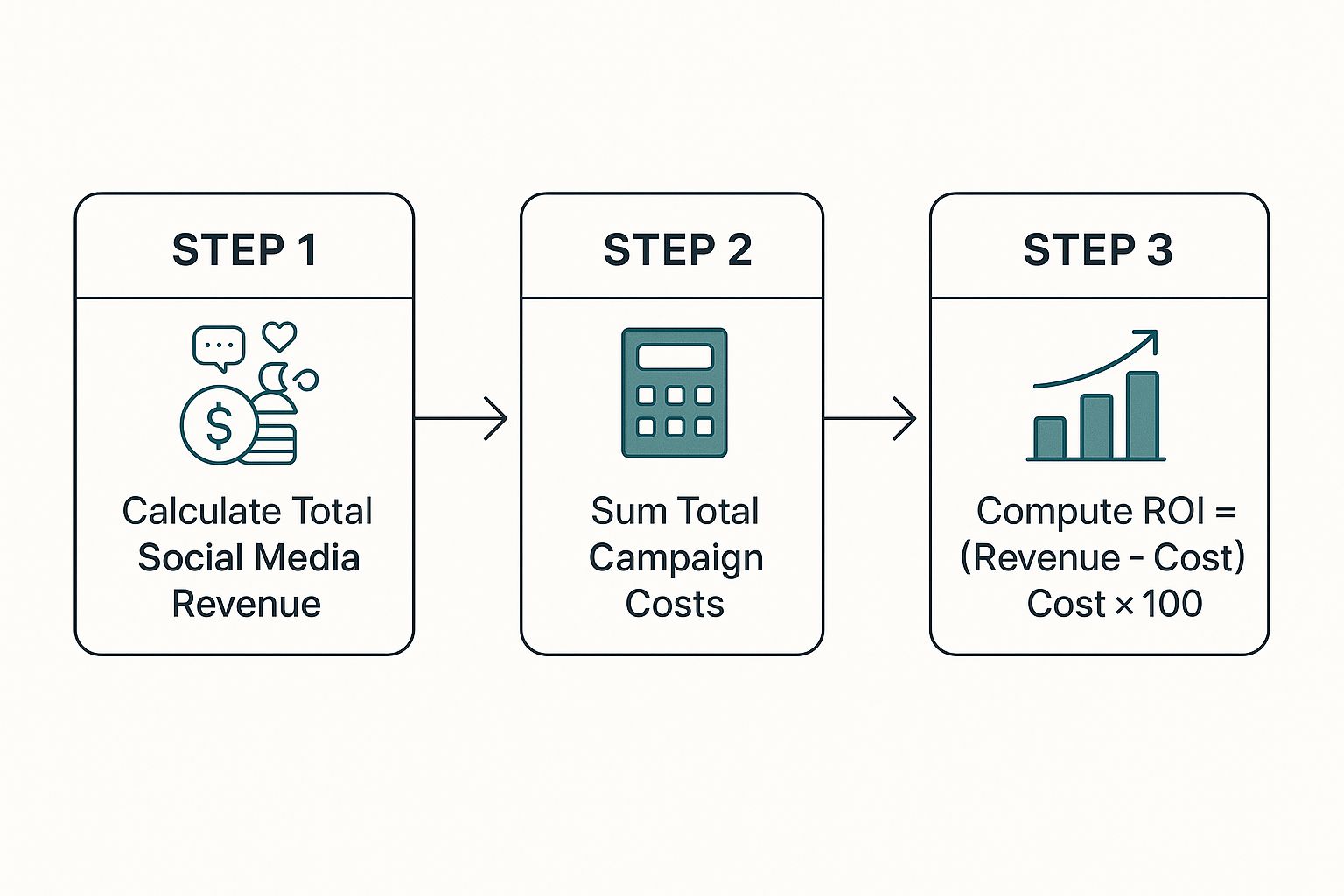
As you can see, it’s really just a three-part process: add up your gains, total your costs, and then see how they stack up against each other.
Tallying Up The True Investment
So many people make the mistake of thinking "investment" is just their ad spend. That's a huge oversight that will give you a dangerously inflated ROI. Your real investment is the sum of every single resource you pour into social media. If you don't track it all, you're not getting an honest look at your profitability.
Here’s what our investment calculation always includes:
- Prorated Team Salaries: If our community manager spends 50% of their time on Reddit and LinkedIn, we attribute 50% of their salary for that period to the cost. And don't forget to account for your own time!
- Content Creation Costs: This bucket holds everything from what we pay freelance writers to the fees for a video editor or graphic designer.
- Tool Subscriptions: We add up the monthly cost for all our social tools—scheduling, analytics, and of course, our own BillyBuzz subscription for monitoring.
- Paid Ad Spend: This is the most obvious one, but it’s critical. It’s the total cash spent on ads across all platforms for that specific campaign.
Add these up, and you get your "Total Investment." It’s the only way to get a true picture of what you're spending.
Assigning a Monetary Value to Your Return
This is where the magic happens—connecting your social media metrics to actual dollars. Your "Return" is the total value generated from all your social activities. For us, it’s not just about direct sales; it’s about the tangible value of the leads we bring in.
Here’s how we put a real number on it.
First, you need to know the Lifetime Value (LTV) of an average customer. Let's imagine your average customer is worth $2,000 to the business over time.
Next, figure out your Lead-to-Customer Rate. If you know that 1 in 10 of your qualified leads ends up becoming a paying customer, your conversion rate is 10%.
With those two figures, calculating the value of a single lead is easy:
Average Value of a Lead = LTV ($2,000) x Lead-to-Customer Rate (10%) = $200
So, if your latest social media campaign brought in 50 qualified leads, your total return is 50 leads x $200/lead = $10,000. That’s your "Total Return."
As a founder, you have to be able to defend every number. Calculating the value of a lead based on LTV gives you a concrete, defensible figure to present to your team, investors, or even just yourself. It anchors your social media efforts in real business value.
Putting It All Together: The ROI Formula
Once you have your Total Return and Total Investment, the last step is a breeze. The standard ROI formula gives you a clean percentage that tells you exactly how profitable your efforts were.
The formula looks like this:
ROI (%) = [(Total Return - Total Investment) / Total Investment] x 100
Let’s plug in our numbers from the example:
- Total Return: $10,000 (from 50 leads)
- Total Investment: $4,000 (salaries, tools, ads)
ROI (%) = [($10,000 - $4,000) / $4,000] x 100
ROI (%) = [$6,000 / $4,000] x 100
ROI (%) = 1.5 x 100 = 150%
A 150% ROI is fantastic. It means for every $1 you put in, you got $2.50 back ($1 to cover your cost, plus $1.50 in pure profit). This single number is the ultimate gut check for your social media strategy. For a deeper dive, check out these proven strategies for calculating social media ROI.
To make this crystal clear, here’s a sample breakdown of how the numbers might look for a real campaign.
Sample Social Media ROI Calculation
| Component | Description | Example Value |
|---|---|---|
| Lifetime Value (LTV) | The total revenue a single customer generates over their lifetime. | $2,000 |
| Lead-to-Customer Rate | The percentage of leads that convert into paying customers. | 10% |
| Value per Lead | The monetary value of one qualified lead (LTV x Rate). | $200 |
| Leads Generated | The total number of qualified leads from the campaign. | 50 |
| Total Return | The total value generated from the leads (Leads x Value per Lead). | $10,000 |
| Total Investment | The sum of all costs (salaries, tools, ad spend, content). | $4,000 |
| Net Profit | The return minus the investment. | $6,000 |
| Final ROI (%) | The net profit divided by the investment, multiplied by 100. | 150% |
This table shows how each piece of the puzzle fits together, moving from high-level business metrics down to a single, powerful percentage that tells the whole story.
Using Your ROI Data to Sharpen Your Social Media Strategy
Getting your social media ROI number is a great start, but it’s what you do next that really counts. If that data just gathers dust in a report, you’ve wasted your time. For us, the numbers are never the finish line; they're the starting pistol for making smarter, more profitable decisions.
This whole process is about creating a powerful feedback loop. You measure, you analyze, you tweak, and you measure again. Each cycle refines your approach, eliminates wasted ad spend, and pushes your returns higher.
Set a Rhythm for Your ROI Reviews
To avoid getting lost in the day-to-day chaos, we stick to a strict review cadence. This rhythm helps us react to immediate issues without losing sight of our long-term goals.
- Monthly Check-ins: These are quick and tactical. We fire up our automated dashboard to hunt for outliers. Did a particular Reddit thread in
r/PPCsend a surprising wave of trial sign-ups? Has our ad spend on LinkedIn suddenly tanked in efficiency? These meetings are about spotting quick wins and putting out small fires. - Quarterly Strategy Reviews: Here’s where we go deep. We zoom out and look at the cumulative ROI across every channel and campaign. This is where the big decisions happen—shifting budgets, doubling down on a content format that’s crushing it, or finally cutting the cord on a platform that just isn’t performing.
This two-track approach keeps us agile enough to respond to short-term trends but disciplined enough to stick to our long-term strategy. The reporting that powers these reviews is critical, and we’ve detailed how we set it up in our guide to building real-time dashboard examples.
Find Your Most Profitable Channels (and Be Ruthless)
After just one quarter of solid tracking, the data will start painting a very clear picture. You’ll begin to see which platforms are your true money-makers and which are just expensive hobbies.
For instance, after looking at our Q2 performance, we saw a massive difference. A deep-dive content series on LinkedIn—which took a ton of time to research—generated a respectable 45% ROI. But our focused outreach in specific subreddits, driven by BillyBuzz alerts, drove an incredible 210% ROI from high-intent leads.
The numbers made the next step obvious. We didn't ditch LinkedIn entirely, but we immediately carved out a piece of that budget to double down on our community engagement efforts in Q3.
ROI data takes the guesswork and ego out of your marketing strategy. It doesn’t matter if you personally love a certain platform or content style. The only thing that matters is whether it delivers a return. Let the numbers be your guide.
The Magic of A/B Testing Your Creative
Once you’ve identified your winning channels, the game shifts to optimizing your performance within them. And the single best tool for that job is relentless A/B testing. We test everything: headlines, ad copy, images, calls-to-action—if you can change it, we'll test it.
Here’s a simple A/B test we ran recently for a Reddit ad campaign:
- Ad A (The Control): Straightforward and focused on our product's features.
- Ad B (The Challenger): Spoke directly to a specific pain point our customers face ("Tired of manually searching Reddit for mentions?").
The results were stunning. Ad B achieved a 3x higher conversion rate and slashed our cost-per-lead almost in half. That one tiny test delivered a huge boost to the campaign's overall ROI.
This data-first mindset is especially critical for bigger bets, like influencer marketing. This channel has become a powerhouse for proving social media ROI, with some studies showing influencer marketing pulls in an average return of $5.78 for every $1 spent. With global social commerce roaring toward becoming a trillion-dollar market, it’s an area you can't afford to ignore.
Common Questions About Measuring Social Media ROI
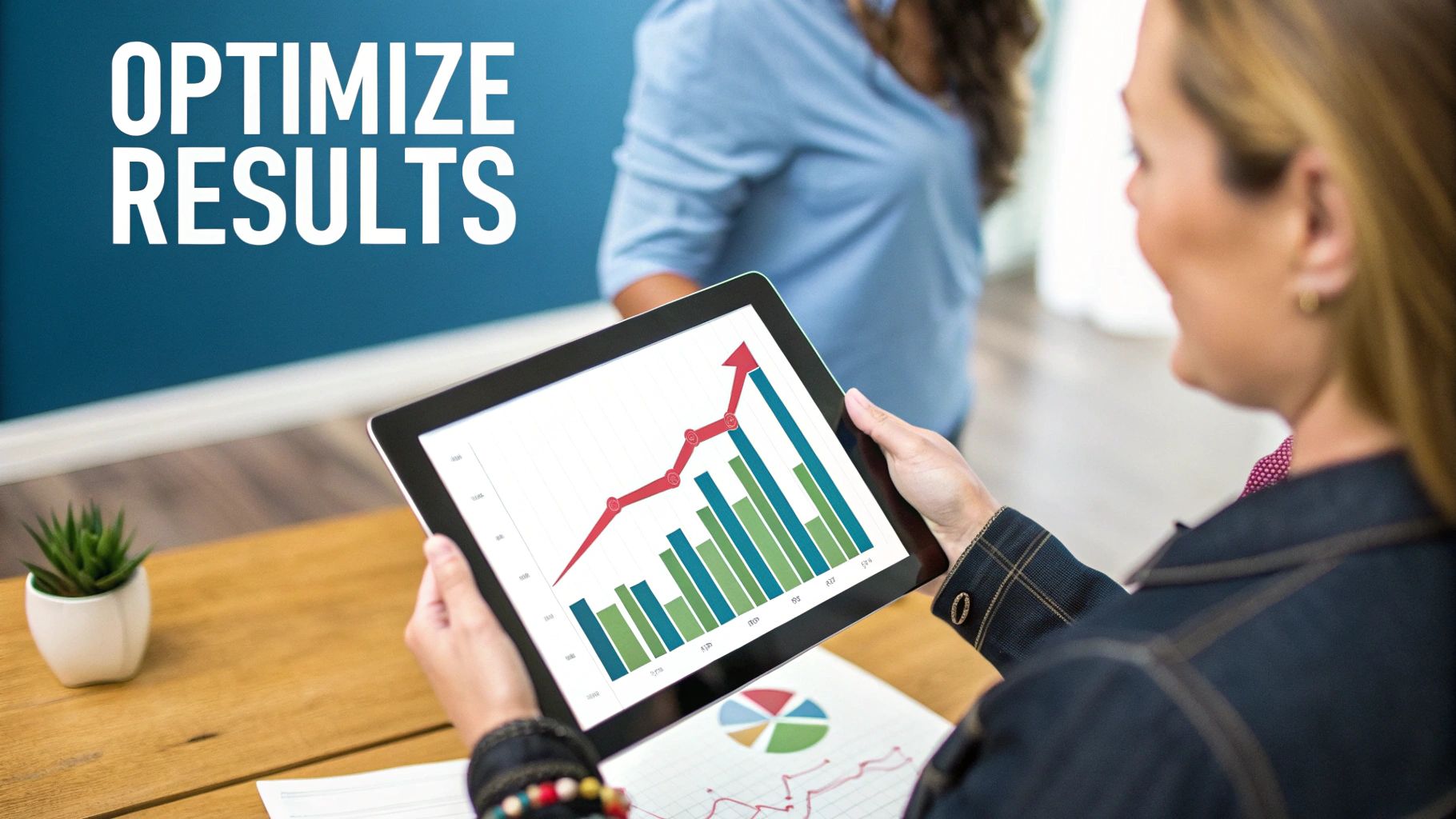
Even with a solid game plan, a few questions always seem to pop up when people get serious about measuring social media ROI. These are the tricky, "what-if" scenarios that can stall your progress.
Let's walk through the most common ones we hear and share the straightforward answers we use to guide our own strategy.
How Often Should I Measure My Social Media ROI?
There's no magic number here, but a balanced rhythm is key.
For a high-level pulse check, we find a monthly review is perfect. It’s enough time to spot trends, catch any red flags, or identify quick wins without getting bogged down in meaningless daily noise. Think of it as your tactical check-in.
The real strategic insights, however, come from a deeper quarterly analysis. This gives your campaigns enough time to actually work and allows you to account for the natural lag in sales cycles.
Especially for a B2B company, a lead from a place like Reddit might take a few months to convert. Measuring ROI too frequently would give you a skewed, incomplete picture. The biggest mistake you can make is obsessively checking numbers every day—social media is a long game, and reacting to every little dip and spike is a recipe for bad decisions.
What Is a Good Social Media ROI Benchmark?
This is the million-dollar question, isn't it? The honest answer is that a "good" ROI depends entirely on your business model, profit margins, and industry. It's not one-size-fits-all.
You'll often hear a 5:1 ratio ($5 in revenue for every $1 spent) thrown around as a strong benchmark, with 10:1 being phenomenal. But take that with a grain of salt. A low-margin e-commerce store might need a much higher return to stay profitable, whereas a SaaS company with a massive customer lifetime value can succeed with a lower initial ROI.
Instead of chasing an arbitrary industry number, focus on your own progress. Measure your ROI for a full quarter to establish a solid baseline. Then, aim to beat it by 10-20% the next quarter. Your most important competitor is your past performance.
How Do I Measure ROI for Brand Awareness Campaigns?
Ah, the classic dilemma. Brand awareness feels fuzzy and hard to pin down, but you can absolutely measure its business impact—you just have to look for the right signals.
Instead of trying to connect every "like" to a dollar, we track proxy metrics that are clear leading indicators of growth.
- Branded Search Volume: Are more people searching for your company by name? We keep a close eye on this in Google Search Console.
- Direct Website Traffic: Is there an uptick in people typing your URL directly into their browser? This is a fantastic sign that your brand is becoming memorable.
- Share of Voice: How does your brand's conversation volume stack up against your competitors? Tools like BillyBuzz are built to measure this specifically for communities like Reddit.
You can also run simple post-purchase surveys asking new customers, "How did you first hear about us?" While you can't assign a specific dollar value to every impression, you can draw a clear, powerful line between your awareness efforts and these crucial signs of growth. This is how you prove that your top-of-funnel work is paying off.
Ready to stop guessing and start knowing which conversations are driving your growth? BillyBuzz uses AI to find your next customers on Reddit, sending you real-time alerts for relevant discussions so you can engage at the perfect moment. Start your free trial today and discover the hidden ROI in community engagement.
